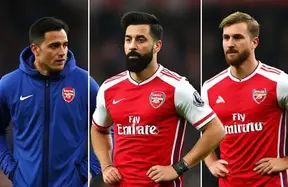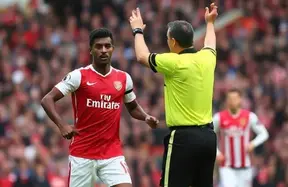A prominent physio analyst sparked debate about whether Martin Odegaard is genuinely injury-prone or simply unlucky with impact knocks. Fans questioned Arsenal’s rotation after he played a full European match midweek before facing West Ham, while others pushed back, noting his issues have largely stemmed from contact rather than recurring soft‑tissue problems. Confusion also surfaced around an unfounded ACL claim, highlighting how quickly misinformation spreads without official updates. From my view as a retired pro, the pattern suggests workload management and game context matter more than any chronic fragility label. The conversation underscores Arsenal’s need for smarter rotation in congested weeks.
A sports physiotherapy analyst raised the topic publicly, promoting an upcoming discussion on Instagram. The prompt drew a lively thread of fan comments debating Arsenal’s rotation choices after a midweek European fixture and the subsequent West Ham match. Some respondents argued that contact-related knocks have shaped recent absences, while others questioned whether the captain should have been benched to manage load. One commenter introduced an ACL rumor that has not been verified by any official medical update, illustrating the volatile nature of crowdsourced injury talk during a congested schedule.
Have Martin Odegaard’s injuries just been unlucky, or is he truly ‘injury prone’? 🔴 🏥 Tune in to our poddy on Instagram to find out, and while you’re over there, please leave us a comment with feedback - we’re trying to grow our reach over there. Thanks legends! 👉
@physioscout
Impact Analysis
The core distinction in this debate is impact injuries versus soft‑tissue problems. Impact injuries (from collisions, kicks, awkward landings) are largely stochastic; they do not usually indicate a chronic predisposition unless there is a history of recurrent structural damage to the same area. By contrast, soft‑tissue or overuse issues (hamstrings, groins, calves) can hint at load mismanagement, biomechanical asymmetries, or conditioning gaps. With Martin Odegaard, the recent pattern aligns more with contact events and short, precautionary rests than with a repeatable soft‑tissue cascade.
Availability data over his Arsenal tenure has generally been strong, with Odegaard featuring heavily across league and European fixtures. When dips occurred, they tended to cluster around fixture congestion or specific knocks. That points to two levers: optimization of his acute-to-chronic workload ratio and smarter substitution windows in matches decided early. Playing a full midweek European game and then starting again days later is not inherently reckless, but it narrows the margin for random contact issues to become time-loss incidents.
Tactically, Arsenal’s dependence on Odegaard’s right‑half space orchestration and pressing triggers increases perceived risk: when he’s absent, their possession structure and counterpress lose clarity. That dependence can distort narratives—every minor setback looks larger. The sensible path is routine load-tuning and clearer role-sharing when score state allows. None of this evidence supports branding him “injury-prone”; it supports refining squad usage during dense periods.
Reaction
Fan responses split into familiar camps. One group insists that back‑to‑back starts after a full European night invited trouble, arguing he should have been eased in versus West Ham—either benched or on a 30‑minute cameo. They frame it as standard post‑UCL practice for high‑value creators. Another cohort pushes back hard, noting that recent issues were impact‑driven, not classic soft‑tissue recurrences, and therefore say the “injury‑prone” label is lazy and uninformed.
There’s also tactical angst: critics suggest Mikel Arteta needs a genuine plan B—someone who can mimic Odegaard’s zone 14 combinations and pressing cues—so the captain isn’t asked to shoulder every creative burden. Names floated include internal options stepping higher or reshaping the right side with more direct runners. Amid this, an alarming ACL claim surfaced from one commenter, which others immediately challenged as baseless. That flashpoint shows how quickly rumor can eclipse reality in a crowded match week. Overall, the sentiment tilts toward cautious load management rather than panic over chronic fragility.
Social reactions
Workflows are trending But look closer: They’re reactionary scripts. If X happens → do Y. That’s not intelligence. And they train on your data while doing it. Skillful workflows go further. Agent-powered: AI that thinks, plans, and adapts in real time. Private by design,
Skillful AI (@SkillfulAI)
The gods are try to tell Mikel that if wants to win the league, he needs to find an alternative to the Odegaard blueprint
Quintessentially (@Hesketh_CW)
Considering he is just coming back from injury and played a full UCL game two days ago on Wednesday, shouldn't he have been rested or at least come off the bench for the West Ham game? Isn't that usually the practice?
Norbrook Child (@ChildNorbrook)
Prediction
Short term, expect Arsenal to modulate Odegaard’s minutes more aggressively in three-game weeks. That likely means controlled substitutions around the 60–70 minute mark when game state allows, plus selective bench starts after demanding European nights. In-possession tasks could be redistributed: the right‑back or right‑8 may shoulder more progression, while wide forwards attack early space to reduce Odegaard’s repeated receptions under contact.
Medium term, Arsenal will expand role redundancy. That can be achieved by rehearsing an alternate structure—either a left‑tilted buildup with the other interior stepping into the half‑space, or a false‑nine drop to replicate Odegaard’s connective tissue between lines. Expect set‑piece creation to cover gaps as well: more rehearsed restarts to offset fewer live‑play touches from the captain.
As for availability, unless an official bulletin indicates otherwise, the trajectory points to episodic, manageable interruptions rather than a long layoff. If Arsenal nail rotation windows and protect him in low-leverage minutes, the “injury‑prone” narrative fades. The true risk is competitive entropy: if plan B remains undercooked, every minor knock will feel like a crisis. Solve the redundancy, and the discourse quiets.
Latest today
- Vinícius Júnior renewal with Real Madrid reportedly stalls - decision window opens
- Real Madrid rift talk - Vinicius Jr vs Xabi Alonso becomes a club-wide debate
- Vinícius Júnior turns down €20m net renewal - pushing for historic Real Madrid deal
- Real Madrid back Xabi Alonso’s reset but worry over Vini Jr tension and dressing room unea...
Conclusion
Strip away the noise and the picture is straightforward: Martin Odegaard does not fit the classic injury‑prone profile. His interruptions map closer to contact events and scheduling pressure than to chronic soft‑tissue recurrence. The smartest move is not alarmism but calibration—rotate him through congested runs, lean on early subs with leads, and share creative load so he avoids repeated high‑traffic collisions. Claims of an ACL have no standing without an official medical line and should be dismissed until verified.
From a former player’s lens, this is about behaviors, not labels: protect your linchpin in low‑leverage phases and train the squad to reproduce his cues. Do that, and Arsenal safeguard both performance and perception. Keep overplaying him in tight cycles, and the conversation will recycle every few weeks. The choice is structural, not medical inevitability.













Skillful AI
Workflows are trending But look closer: They’re reactionary scripts. If X happens → do Y. That’s not intelligence. And they train on your data while doing it. Skillful workflows go further. Agent-powered: AI that thinks, plans, and adapts in real time. Private by design,
Quintessentially
The gods are try to tell Mikel that if wants to win the league, he needs to find an alternative to the Odegaard blueprint
Norbrook Child
Considering he is just coming back from injury and played a full UCL game two days ago on Wednesday, shouldn't he have been rested or at least come off the bench for the West Ham game? Isn't that usually the practice?
Mark Tuite
How are impact injuries now making him injury prone, that’s just a general lack of knowledge or pure ignorance
Life is Fun!
So, finally, for how long he will be out after ACL injury vs West Ham?
.. SI
How can he be injury prone when they are impact injuries
mwansa🇿🇲
Injury prone, how?
Jørdan🦦
clearly unlucky
CoinPoker
What playing through a downswing feels like
Sean Tinney
I investigated the media narratives around Charlie Kirk and found significant discrepancies between what was reported and what actually happened. (Link in reply) How do YOU cut through media rhetoric to find the truth?
Upland
Upland is the city-builder where what you create actually matters. - Own real-world properties. - Build neighborhoods that attract digital residents called Uppies. - Trade, earn, and grow a city that never resets.